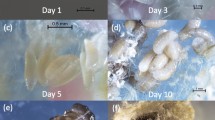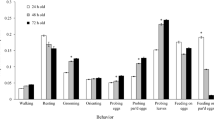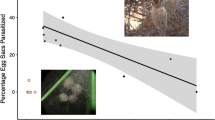Summary
The incidence of the parasites in the egg sacs of the spider Argiope pulchella was 100% for Sarcophaga banksi and 25% for Tachinobia repanda. In 1976, 237 spider eggs equivalent to 131 gcal/m2 were present. Of these, 212 eggs/m2 (=117 gcal) were consumed by S. banksi larvae, leaving 25 spiderlings/m2 (=14 gcal) to emerge. The density of S. banksi larvae was l/m2 (=87 gcal), of which 0.7/m2 S. banksi (=41 gcal) successfully emerged; as few as 0.3 S. banksi/m 2(=25 gcal) were infected by T. repanda; only 14 T. repanda/m2 (=8 gcal) successfully emerged. Exploitation efficiency was 89% for S. banksi and 29% for T. repanda. Ecological efficiency was 66% for S. banksi and only 9% for T. repanda. The egg sac area of A. pulchella holds a straight line relationship to the energy content of the eggs; the sacs were grouped into 8 different sizes and each one further into groups containing 1, 2, and 3 S. banksi larvae per sac. Analysis of the sacs at the appropriate time revealed that an S. banksi larva consumed a minimum of 114 eggs (=70 gcal), when present as one of a pair in the smallest sac (0.6 cm2 area), and a maximum of 476 eggs (=234 gcal), when present alone in the largest sac (1.3 cm2). Despite this wide difference in food intake, all S. banksi (barring those infected by T. repanda) successfully emerged. The energy content of a pharate pupa, which was 125, 92, and 68 gcal in a sac with 1 cm2 area containing 1, 2, or 3 S. banksi, depended on the size of the sac and the number of S. banksi per sac. The corresponding values for the imago were 82, 61, and 45 gcal. The efficiency of S. banksi ranged between 60 and 80% for food conversion and between 35 and 56% for pupation.
Similar content being viewed by others
References
Arthur, A.P., Coppel, H.C.: Studies on dipterous parasites of the spruce budworm Choristoneura fumiferana (Clem) (Lepidoptera: Tortricidae). 1 Sarcophaga aldrichi Park (Diptera: Sarcophagidae). Canad. J. Zool. 31, 374–391 (1953)
Carlos, V.: Parasitism in eggs of the spider Achaeranea tepidariorum (Kock) (Aranea: Therididae) in Costa Rica. Rev. Biol. Trop. 18, 99–106 (1972)
Edgar, W.D.: Aspects of the ecological energetics of the wolf spider Pardosa (Lycosa) lugubris (Walckenaer). Oecologia (Berl.) 7, 136–154 (1971a)
Edgar, W.D.: Aspects of the ecology and energetics of the egg sac parasites of the wolf spider Pardosa lugubris (Walckenaer). Oecologia (Berl.) 7, 155–163 (1971b)
Engelmann, F.: Energetics, terrestrial field studies and animal productivity. Adv. Ecol. Res. 3, 73–115 (1966)
Haniffa, M.A., Pandian, T.J.: Morphometry, primary productivity and energy flow in a tropical pond. Hydrobiol. (in press, 1978)
Kajak, A.: An analysis of food relations between the spiders Araneus cornutus Clerck and Araneus quadratus Clerck and their prey in meadows. Ekol. Pol. 13A, 717–764 (1965)
Kessler, A., Fokkinga, A.: Hymenopterous parasites in egg sacs of spiders of the genus Pardosa (Araneida: Lycosidae). Tijdschr. Entomol. 116, 46–61 (1973)
Lawton, J.H.: Studies on the ecological energetics of damselfly larvae (Odonata: Zygoptera). Ph.D. Thesis, Durham University (1969)
Mathavan, S., Muthukrishnan, J.: Effects of ration levels and restriction of feeding durations on food utilisation in Danaus chrysippus (Lepidoptera: Danaidae). Ent. Exptl. et Appl. 19, 155–162 (1976)
Moon, B.J., Carefoot, T.H.: The energy requirements of metamorphosis of the greater wax moth Galleria mellonella (L.). Canad. J. Zool. 50, 67–75 (1972)
Moulder, B.C., Reichle, D.E.: Significance of spider predation in the energy dynamics of forest-floor Arthropod communities. Ecol. Monogr. 42, 473–498 (1972)
Mukerji, M.K., LeRoux, E.J.: A study on energetics of Podisus maculiventris (Hemiptera: Pentatomidae). Can. Ent. 101, 449–460 (1969)
Pandian, T.J., Delvi, M.R.: Observations on the mortality of the grasshopper Poecilocerus pictus (Fab.) infected by sarcophagous parasite Blaesoxipha kaestneri. Indian J. Ent. 35, 50–52 (1973)
Pandian, T.J., Mathavan, S.: Patterns of energy utilisation in the tropical dragonfly Diplacodes trivialis (Rambur), and some other aquatic insects (Anisoptera: Libellulidae). Odonatologica 3, 241–248 (1974)
Petrusewicz, K., Macfadyen, A.: Productivity of terrestrial animals. IBP Handbook No. 13, pp. 190. Oxford: Blackwell 1970
Stockner, J.G.: Ecological energetics and natural history of Hedriodiscus truquii (Diptera) in two thermal spring communities. J. Fish. Res. Bd. Can. 28, 73–94 (1971)
Van Hook, R.I.: Energy and nutrient dynamics of spider and orthopteran populations in a grassland ecosystem. Ecol. Monogr. 41, 1–26 (1971)
Author information
Authors and Affiliations
Additional information
This work was completed at our Palni Centre
Rights and permissions
About this article
Cite this article
Prakash, R.N., Pandian, T.J. Energy flow from spider eggs through dipteran parasite and hymenopteran hyperparasite populations. Oecologia 33, 209–219 (1978). https://doi.org/10.1007/BF00344849
Received:
Issue Date:
DOI: https://doi.org/10.1007/BF00344849




